mmcartalk
Expert
- Messages
- 4,159
- Reactions
- 2,675
MM Retro Write-Up: 1974-1978 Ford Mustang II
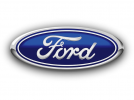
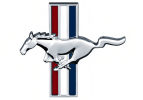
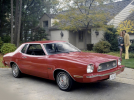
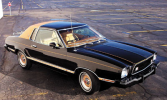



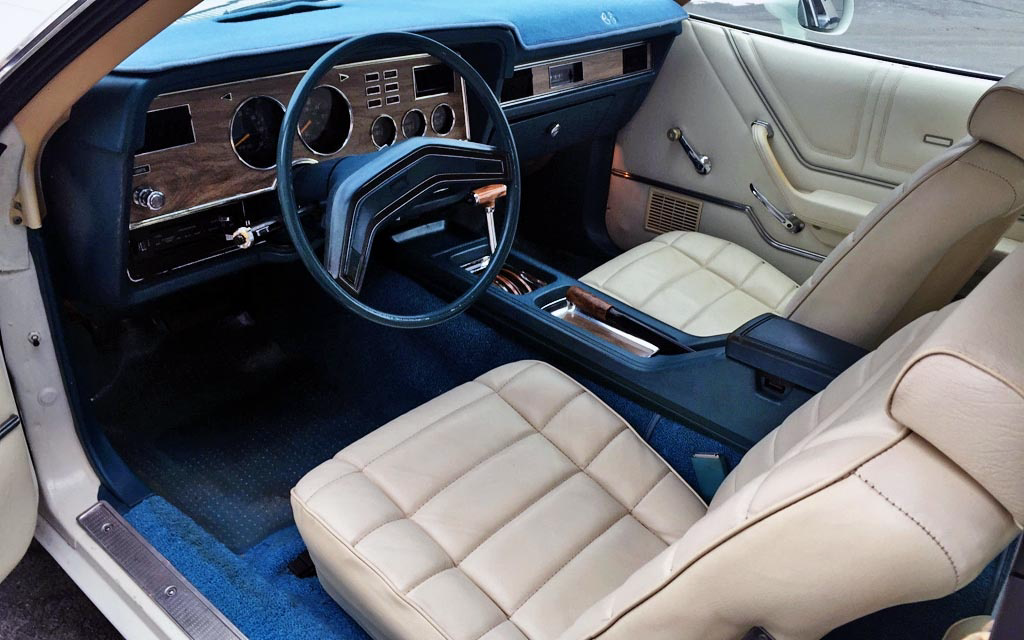



IN A NUTSHELL: IMO unfairly panned in the auto press, and a return to the size of the original Mustang.
Much has been written in the auto press over the years (mostly negative) about Ford’s downsized Mustang II. For the most part, I disagree…..for reasons which I will explain in this write-up.
The original Mustang, unveiled in April of 1964 to some of the greatest hype ever given to an American vehicle-introduction, was designed as a compact sport-oriented-coupe, based on the Ford Falcon platform, and sharing much of its frame, running-gear, engine/transmission, suspension, and steering wth its more mundane Falcon stablemate. The Mustang differed mainly in the (IMO) excellent-looking body and interior, which attracted buyers in droves. Later on, the term “Ponycar” would be used to describe the Mustang and its Camaro, Barracuda/Challenger, Cougar, Javelin, and Firebird competitors….the term “Pony” of course, as a reference to the Mustang’s galloping-horse-symbol.
Over the next decade, however, the Mustang grew in length, width, weight, and power, particularly after Carroll Shelby, who had reworked the original high-powered AC Cobra and had helped Ford so much, with the GT-40, to compete against (and beat) Ferrari on the Formula One race-tracks, reworked the Mustang into a truly high-performance machine with its distinctive blue and white paint job and stripes. Additional high-performance versions of the Mustang, like the Boss 302/429, Cobra-Jet CJ, and Mach I, were introduced in 1969/70, along with even more size and weight.
In the early 1970s, the Mustang grew even longer, but build quality/solidness declined somewhat, the rear fastback grew ridiculously flat (which greatly impacted rear visibility and made it easy for snow to build up), and it simply was not the same car anymore that it was originally designed to be. Lee Iacocca, who by this time was President of Ford, ordered an all-new Mustang for 1974, shaved back down to more or less its original dimensions. Originally, the 1974 Mustang was going to use the Maverick’s compact platform, but it decided to use the Pinto’s instead.
And this is is where the auto press started panning the new Mustang II….using the Pinto’s platform and markedly downsizing the engines from those of the previous 7-8 years or so. Auto writers laughed at it and basically called it a toy. I disagreed….for several reasons. First, with the possible exception of Pontiac’s Trans-Am, virtually all of Detroit’s muscle-cars of that era, as a result of emissions, CAFE regulations, and increasing insurance-premiums, if not dropped altogether, were being either downsized, de-powered, or both….and the Mustang II was obviously not going to be any different. Second, after the original 2.3L in-line four and 2.8L V6s were offered in 1974, starting in 1975, people who wanted more power could order the 4.9L (302 c.i.) V8 in the Cobra and Mach I packages. No, it was not the same as the big tire-shredding V8s of 69/70 before they were also de-powered from emission controls, but the 302 had enough spunk to at least get out of its own way. Cobra II and King Cobra packages became available later. Ghia and Stallion trim packages were also available at various times in the model-run. Third, although it was done on the Pinto’s platform (and the basic body styling was somewhat similar), the Mustang II had more attention paid to its rear frame and structural strength, and was more resistant to the fuel-tank going up like a Roman candle in a rear-end-impact. Fourth, unlike the auto press, I saw it as no big deal that Ford decided to use the Pinto platform for the Mustang II…..as long as they didn’t cheap out on the proper engineering like they did with the Pinto to try and save weight and cost. Fifth, one reason the Mustang II looked less-sleek and more bulbous in front compared to earlier versions was because of the Federal Bumper Standard of 1973, which, with the technology of the time, required those large heavy extended bumpers that messed up the looks of many American cars of the period.
So, given what the economic circumstances of the country were at the time, the strong regulatory climate, the high insurance premiums for sporty and high-performance cars, the lessening-demand for this type of vehicle as many buyers were either starting to look at compacts and sub-compacts for gas mileage, the still-small but steadily-rising tide of Japanese imports, and the better engineering of the Mustang II compared to the Pinto, personally, I think its design made sense, and I liked its looks apart from the large heavy bumpers. In fact, I liked it a lot more than the later versions which were built from the late 1970s through the early 2000s. I thought they were all super-cheaply done inside and out, and none of those versions (even the Cobras) really interested me, although I did test-drive a new Cobra Mustang with the Hurst manual transmission in the 90s (I don’t remember exactly which year). Ford was advertising each Cobra engine as hand-built and signed off by a Factory Technician, but I wasn’t impressed with its actual on-road performance, and Ford later admitted publicly that the power-level of those engines was somewhat overrated. In 2005, once again, came a REAL Mustang, that, although slightly larger than the original ’64-66 Mustang and later Mustang II, restored much of the vintage-Mustang’s pony-good looks and power-levels under the hood….not to mention a much better interior than the late-70s-early 2000s versions. From then on, the Mustang became a real American icon again….the rest is history.
And, as Always, Happy-Vehicle-Memories
MM











IN A NUTSHELL: IMO unfairly panned in the auto press, and a return to the size of the original Mustang.
Much has been written in the auto press over the years (mostly negative) about Ford’s downsized Mustang II. For the most part, I disagree…..for reasons which I will explain in this write-up.
The original Mustang, unveiled in April of 1964 to some of the greatest hype ever given to an American vehicle-introduction, was designed as a compact sport-oriented-coupe, based on the Ford Falcon platform, and sharing much of its frame, running-gear, engine/transmission, suspension, and steering wth its more mundane Falcon stablemate. The Mustang differed mainly in the (IMO) excellent-looking body and interior, which attracted buyers in droves. Later on, the term “Ponycar” would be used to describe the Mustang and its Camaro, Barracuda/Challenger, Cougar, Javelin, and Firebird competitors….the term “Pony” of course, as a reference to the Mustang’s galloping-horse-symbol.
Over the next decade, however, the Mustang grew in length, width, weight, and power, particularly after Carroll Shelby, who had reworked the original high-powered AC Cobra and had helped Ford so much, with the GT-40, to compete against (and beat) Ferrari on the Formula One race-tracks, reworked the Mustang into a truly high-performance machine with its distinctive blue and white paint job and stripes. Additional high-performance versions of the Mustang, like the Boss 302/429, Cobra-Jet CJ, and Mach I, were introduced in 1969/70, along with even more size and weight.
In the early 1970s, the Mustang grew even longer, but build quality/solidness declined somewhat, the rear fastback grew ridiculously flat (which greatly impacted rear visibility and made it easy for snow to build up), and it simply was not the same car anymore that it was originally designed to be. Lee Iacocca, who by this time was President of Ford, ordered an all-new Mustang for 1974, shaved back down to more or less its original dimensions. Originally, the 1974 Mustang was going to use the Maverick’s compact platform, but it decided to use the Pinto’s instead.
And this is is where the auto press started panning the new Mustang II….using the Pinto’s platform and markedly downsizing the engines from those of the previous 7-8 years or so. Auto writers laughed at it and basically called it a toy. I disagreed….for several reasons. First, with the possible exception of Pontiac’s Trans-Am, virtually all of Detroit’s muscle-cars of that era, as a result of emissions, CAFE regulations, and increasing insurance-premiums, if not dropped altogether, were being either downsized, de-powered, or both….and the Mustang II was obviously not going to be any different. Second, after the original 2.3L in-line four and 2.8L V6s were offered in 1974, starting in 1975, people who wanted more power could order the 4.9L (302 c.i.) V8 in the Cobra and Mach I packages. No, it was not the same as the big tire-shredding V8s of 69/70 before they were also de-powered from emission controls, but the 302 had enough spunk to at least get out of its own way. Cobra II and King Cobra packages became available later. Ghia and Stallion trim packages were also available at various times in the model-run. Third, although it was done on the Pinto’s platform (and the basic body styling was somewhat similar), the Mustang II had more attention paid to its rear frame and structural strength, and was more resistant to the fuel-tank going up like a Roman candle in a rear-end-impact. Fourth, unlike the auto press, I saw it as no big deal that Ford decided to use the Pinto platform for the Mustang II…..as long as they didn’t cheap out on the proper engineering like they did with the Pinto to try and save weight and cost. Fifth, one reason the Mustang II looked less-sleek and more bulbous in front compared to earlier versions was because of the Federal Bumper Standard of 1973, which, with the technology of the time, required those large heavy extended bumpers that messed up the looks of many American cars of the period.
So, given what the economic circumstances of the country were at the time, the strong regulatory climate, the high insurance premiums for sporty and high-performance cars, the lessening-demand for this type of vehicle as many buyers were either starting to look at compacts and sub-compacts for gas mileage, the still-small but steadily-rising tide of Japanese imports, and the better engineering of the Mustang II compared to the Pinto, personally, I think its design made sense, and I liked its looks apart from the large heavy bumpers. In fact, I liked it a lot more than the later versions which were built from the late 1970s through the early 2000s. I thought they were all super-cheaply done inside and out, and none of those versions (even the Cobras) really interested me, although I did test-drive a new Cobra Mustang with the Hurst manual transmission in the 90s (I don’t remember exactly which year). Ford was advertising each Cobra engine as hand-built and signed off by a Factory Technician, but I wasn’t impressed with its actual on-road performance, and Ford later admitted publicly that the power-level of those engines was somewhat overrated. In 2005, once again, came a REAL Mustang, that, although slightly larger than the original ’64-66 Mustang and later Mustang II, restored much of the vintage-Mustang’s pony-good looks and power-levels under the hood….not to mention a much better interior than the late-70s-early 2000s versions. From then on, the Mustang became a real American icon again….the rest is history.
And, as Always, Happy-Vehicle-Memories
MM
